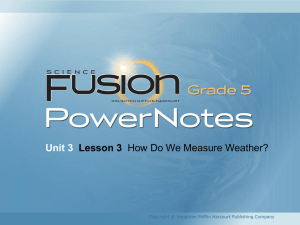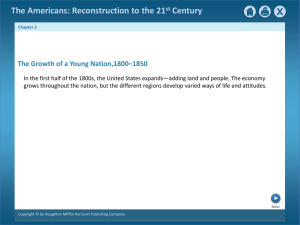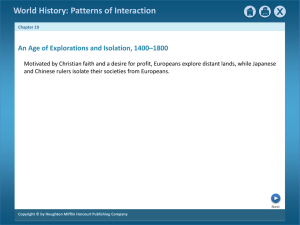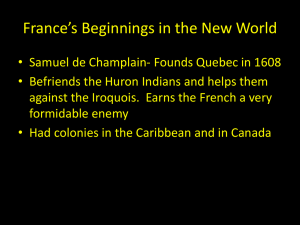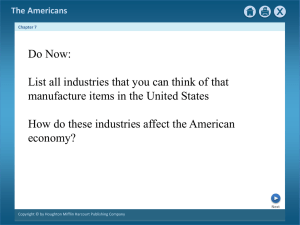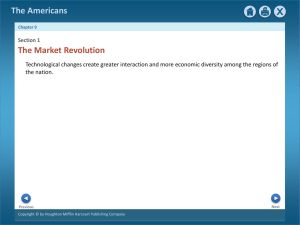Roaring 20s: American Life, Women, Harlem Renaissance
advertisement
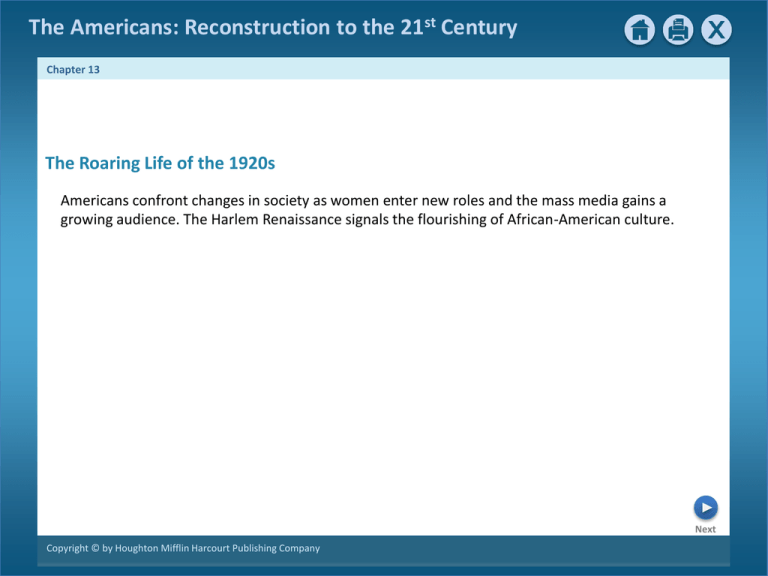
The Americans: Reconstruction to the 21st Century
Chapter 13
The Roaring Life of the 1920s
Americans confront changes in society as women enter new roles and the mass media gains a
growing audience. The Harlem Renaissance signals the flourishing of African-American culture.
Next
Copyright © by Houghton Mifflin Harcourt Publishing Company
The Americans: Reconstruction to the 21st Century
Chapter 13
The Roaring Life of the 1920s
SECTION 1
Changing Ways of Life
SECTION 2
The Twenties Woman
SECTION 4 The Harlem Renaissance
Section-3
Previous
Copyright © by Houghton Mifflin Harcourt Publishing Company
Next
The Americans: Reconstruction to the 21st Century
Chapter 13
Section 1
Changing Ways of Life
Americans experience cultural conflicts as customs and values change in the 1920s.
Previous
Copyright © by Houghton Mifflin Harcourt Publishing Company
Next
The Americans: Reconstruction to the 21st Century
Chapter 13
Section 1
Changing Ways of Life
Rural and Urban Differences
The New Urban Scene
• 1920 census: 51.2% of Americans in communities of 2,500 or more
• 1922–1929, nearly 2 million people leave farms, towns each year
• Largest cities are New York, Chicago, Philadelphia
— 65 other cities with 100,000 people or more
• In 1920s, people caught between rural, urban cultures
— close ties, hard work, strict morals of small towns
— anonymous crowds, moneymaking, pleasure seeking of cities
Continued…
Previous
Copyright © by Houghton Mifflin Harcourt Publishing Company
Next
The Americans: Reconstruction to the 21st Century
Chapter 13
Section 1
Rural and Urban Differences
The Prohibition Experiment
• 18th Amendment launches Prohibition era
— supported by religious groups, rural South, West
• Prohibition—production, sale, transportation of alcohol illegal
• Government does not budget enough money to enforce the law
Speakeasies and Bootleggers
• Speakeasies (hidden saloons, nightclubs) become fashionable
• People distill liquor, buy prescription alcohol, sacramental wine
• Bootleggers smuggle alcohol from surrounding countries
Continued…
Previous
Copyright © by Houghton Mifflin Harcourt Publishing Company
Next
The Americans: Reconstruction to the 21st Century
Chapter 13
Section 1
Rural and Urban Differences {continued}
Organized Crime
•
•
•
•
Prohibition contributes to organized crime in major cities
Al Capone controls Chicago liquor business by killing competitors
By mid-1920s, only 19% support Prohibition
18th Amendment in force until 1933; repealed by 21st Amendment
Previous
Copyright © by Houghton Mifflin Harcourt Publishing Company
Next
The Americans: Reconstruction to the 21st Century
Chapter 13
Section 1
Science and Religion Clash
American Fundamentalism
• Fundamentalism—movement based on literal interpretation of Bible
• Fundamentalists skeptical of some scientific discoveries, theories
— reject theory of evolution
• Believe all important knowledge can be found in Bible
• Fundamentalist preachers lead religious revivals in South, West
— Billy Sunday holds emotional meetings
— Aimee Semple McPherson uses showmanship while preaching on radio
Continued…
Previous
Copyright © by Houghton Mifflin Harcourt Publishing Company
Next
The Americans: Reconstruction to the 21st Century
Chapter 13
Section 1
Science and Religion Clash {continued}
The Scopes Trial
•
•
•
•
•
1925, Tennessee passes law making it a crime to teach evolution
American Civil Liberties Union backs John T. Scopes challenge of law
Clarence Darrow, most famous trial lawyer of day, defends Scopes
Fundamentalist William Jennings Bryan is special prosecutor
Scopes trial—debates evolution, role of science, religion in school
— national sensation; thousands attend
• Bryan admits Bible open to interpretation; Scopes found guilty
Previous
Copyright © by Houghton Mifflin Harcourt Publishing Company
Next
The Americans: Reconstruction to the 21st Century
Chapter 13
Section-2
The Twenties Woman
American women pursue new lifestyles and assume new jobs and different roles in society during
the 1920s.
Previous
Copyright © by Houghton Mifflin Harcourt Publishing Company
Next
The Americans: Reconstruction to the 21st Century
Chapter 13
Section 2
The Twenties Woman
Young Women Change the Rules
The Flapper
• Flapper—emancipated young woman, adopts new fashions, attitudes
• Many young women want equal status with men, become assertive
• Middle-class men, women begin to see marriage as equal partnership
— housework, child-rearing still woman’s job
The Double Standard
• Elders disapprove new behavior and its promotion by periodicals, ads
• Casual dating begins to replace formal courtship
• Women subject to double standard (less sexual freedom than men)
— must observe stricter standards of behavior
Previous
Copyright © by Houghton Mifflin Harcourt Publishing Company
Next
The Americans: Reconstruction to the 21st Century
Chapter 13
Section-2
Women Shed Old Roles at Home and at Work
New Work Opportunities
•
•
•
•
•
After war, employers replace female workers with men
Female college graduates become teachers, nurses, librarians
Many women become clerical workers as demand rises
Some become sales clerks, factory workers
Few become managers; always paid less than men
Continued…
Previous
Copyright © by Houghton Mifflin Harcourt Publishing Company
Next
The Americans: Reconstruction to the 21st Century
Chapter 13
Section-2
Women Shed Old Roles at Home and at Work {continued}
The Changing Family
•
•
•
•
•
Birthrate drops partly due to more birth-control information
Manufactured products, public services give homemakers freedom
Housewives can focus more on families, pastimes, not housework
Marriages increasingly based on romantic love, companionship
Children spend most of day at school, organized activities
— adolescents resist parental control
• Working-class, college-educated women juggle family, work
Previous
Copyright © by Houghton Mifflin Harcourt Publishing Company
Next
The Americans: Reconstruction to the 21st Century
Chapter 13
Section-4
The Harlem Renaissance
African-American ideas, politics, art, literature, and music flourish in Harlem and elsewhere in the
United States.
Previous
Copyright © by Houghton Mifflin Harcourt Publishing Company
Next
The Americans: Reconstruction to the 21st Century
Chapter 13
Section-4
The Harlem Renaissance
African-American Voices in the 1920s
The Move North
• 1910–1920, Great Migration of thousands of African Americans
— move from South to Northern cities
• By 1920, over 40% of African Americans live in cities
• Racial tensions escalate in North; about 25 urban race riots in 1919
• African-Americans continue to migrate in large numbers in 1920s
Continued…
Previous
Copyright © by Houghton Mifflin Harcourt Publishing Company
Next
The Americans: Reconstruction to the 21st Century
Chapter 13
Section-4
African-American Voices in the 1920s {continued}
African-American Goals
• National Association for the Advancement of Colored People (NAACP)
— protests racial violence
• NAACP leader James Weldon Johnson fights for civil rights legislation
• NAACP antilynching campaign leads to drop in number of lynchings
Marcus Garvey and the UNIA
• Marcus Garvey founds Universal Negro Improvement Association (UNIA)
— believes African Americans should build separate society
• Garvey promotes black pride, black businesses, return to Africa
Previous
Copyright © by Houghton Mifflin Harcourt Publishing Company
Next
The Americans: Reconstruction to the 21st Century
Chapter 13
Section-4
The Harlem Renaissance Flowers in New York
African-American Writers
• Harlem world’s largest black urban area; people from U.S., Caribbean
• Harlem Renaissance—African-American literary, artistic movement
— express pride in African-American experience
• Claude McKay’s poems urge blacks to resist prejudice, discrimination
• Langston Hughes’s poems describe difficult lives of working class
— many written in jazz, blues tempo
• Zora Neale Hurston shows folkways, values of poor, Southern blacks
Continued…
Previous
Copyright © by Houghton Mifflin Harcourt Publishing Company
Next
The Americans: Reconstruction to the 21st Century
Chapter 13
Section-4
The Harlem Renaissance Flowers in New York {continued}
African-American Performers
• Influence, popularity of Harlem Renaissance go beyond black audience
• Musical comedy Shuffle Along launches movement
— is popular with white audiences
• African-American performers win large followings
• Paul Robeson—major dramatic actor in London, New York
Continued…
Previous
Copyright © by Houghton Mifflin Harcourt Publishing Company
Next
The Americans: Reconstruction to the 21st Century
Chapter 13
Section-4
The Harlem Renaissance Flowers in New York {continued}
African Americans and Jazz
• Jazz born in early 20th century New Orleans, spreads across U.S.
• Trumpeter Louis Armstrong makes personal expression key part of jazz
— most influential musician in jazz history
• Edward Kennedy “Duke” Ellington—jazz pianist, orchestra leader
— one of America’s greatest composers
• Cab Calloway, Armstrong popularize scat (improvised jazz singing)
• Bessie Smith—blues singer, perhaps best vocalist of decade
Previous
Copyright © by Houghton Mifflin Harcourt Publishing Company
Next
The Americans: Reconstruction to the 21st Century
Chapter 13
This is the end of the chapter presentation of lecture notes.
Click the HOME or EXIT button.
Previous
Copyright © by Houghton Mifflin Harcourt Publishing Company
Next
The Americans: Reconstruction to the 21st Century
Chapter 13
Print Slide Show
1. On the File menu, select Print
2. In the pop-up menu, select Microsoft
PowerPoint If the dialog box does not
include this pop-up, continue to step 4
3. In the Print what box, choose the
presentation format you want to print:
slides, notes, handouts, or outline
4. Click the Print button to print the
PowerPoint presentation
Previous
Copyright © by Houghton Mifflin Harcourt Publishing Company


